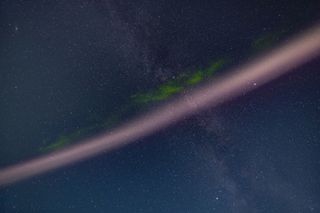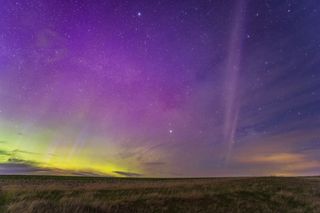What is STEVE, and how is it different from the aurora?
Only formally discovered in 2016, STEVE is a mysterious atmospheric phenomenon that is linked to yet distinct from the aurora. Here's where to look for it in the night sky.

The aurora might be the most famous atmospheric phenomenon in our night sky, but it certainly isn't the only one. If you've not yet been introduced, we'd love you to meet STEVE.
STEVE — Strong Thermal Emission Velocity Enhancement — is an aurora-like glow that often accompanies the northern lights, yet is a distinct phenomenon, according to the American Geophysical Union (AGU). STEVE was discovered between 2015 and 2016, not by professional astronomers or physicists, but by citizen scientists in Canada chasing the aurora, according to the first study published on STEVE in Science Advances in 2018.
Now, researchers are studying STEVE with vigor, and keeping a close eye on the night sky to see it themselves.
Related: Aurora colors: What causes them and why do they vary?
What is STEVE?
STEVE is a streak of purplish light in the night sky that's similar to an aurora. In fact, STEVE has only ever been observed in conjunction with an aurora. That's because both phenomena are thought to be created by the same space weather events, according to the European Space Agency (ESA).
When energized particles from the sun crash into Earth, our magnetic field redirects the particles toward the north and south poles.
The electrically charged particles then enter Earth's atmosphere, exciting gas atoms and molecules and generating the aurora borealis (northern lights) and the aurora australis (southern lights). The process is similar to how neon lights work: When the molecules and atoms get "excited" by electrons, they must return to their original energy (ground state) and do so by releasing the energy as photons (light).
At the same time, some of these solar emissions (in the form of super-speedy streams of plasma) heat gas in the upper atmosphere, and that's what creates STEVE, according to the National Oceanic and Atmospheric Administration (NOAA). Thus, STEVE is hot, glowing gas.
Who discovered STEVE and when?

The first paper about STEVE was published in 2018, but it was inspired by the work of amateur aurora chasers and citizen scientists from the Facebook group Alberta Aurora Chasers, according to the CBC. The group had photographed the phenomenon multiple times between 2015 and 2016, and they brought their observations to space scientists Elizabeth MacDonald from NASA and Eric Donovan from the University of Calgary at a pub one night after a lecture. The researchers began an investigation into STEVE — then known as just plain-old Steve (more on that later) — which led to that first paper.
Interestingly, mentions of STEVE (though not by that name), exist in the historical record — we just forgot all about them. "After STEVE became popular, scientists went back to historical observations of aurora and realized that a STEVE-like phenomenon had been reported back in the 1890s and 1910s," STEVE researcher Toshi Nishimura of Boston University and a co-author on the original STEVE paper told Space.com. "There were no colored photographs back then, so it is difficult to confirm if it was really STEVE or not. But the description they made about the emission, 'a luminous band...like a straight tail of a large comet,' matches how we now characterize STEVE."
STEVE FAQs
What is STEVE in an aurora?
STEVE is not an aurora, though they both are glowing atmospheric phenomena. It does, however, occur simultaneously with an aurora, as the same process fuels both phenomena. That said STEVE does not always appear when there is an aurora, and we're not sure why.
What's the difference between STEVE and the aurora?
Visually, STEVE appears to be a mauve or magenta streak across the sky, whereas the aurora usually appears as green ribbons. Physically, STEVE is created by heated gas that glows, whereas the aurora is created by charged particles that glow.
Why is STEVE rare?
While we haven't seen very much of STEVE yet, it might not be as rare as you might think. We hadn't noticed it for so long because scientists simply hadn't been looking in the right part of the night sky. Now that we're studying STEVE more, we may discover it's not very rare at all, just like the aurora. Anecdotally, though, it does appear less frequently than the aurora, but we aren't sure why.
What does the name STEVE stand for?

Today, STEVE stands for Strong Thermal Emission Velocity Enhancement. But the name has a fun backstory — STEVE is a backronym, or a reverse-engineered acronym.
According to the CBC, the Canadian aurora chasers who photographed the phenomenon were the first to dub it "Steve." Why? In the animated film "Over the Hedge", animal characters discover a mysterious hedge, and they decide to name it "Steve" in an attempt to make it seem less scary. The same could be said for the celestial Steve.
Once Steve became a true scientific discovery, researchers gave the phenomenon the acronym STEVE as a nod to the work of the Alberta Aurora Chasers.
How can you see STEVE?
STEVE occurs at lower latitudes than the aurora, meaning you can see it farther south than the auroral oval, according to Nishimura. Based on our current knowledge of STEVE, your best chance to see it would be during a major geomagnetic storm — the same type of storm that produces vibrant aurora. Nishimura notes that the odds are stronger in the fall and the spring, sometime before midnight. But STEVE is still a relatively rarely spotted phenomenon. So far, it has only ever been seen in conjunction with the aurora.
STEVE Q&A with an expert
We asked STEVE researcher Toshi Nishimura, a professor at Boston University's College of Engineering, a few frequently asked questions about STEVE.
Toshi Nishimura was a co-author on the original STEVE research paper. Nishimura studies auroras, solar wind-magnetosphere-ionosphere interactions and upper atmosphere physics.
What causes STEVE?
STEVE is a glow of hot gas in the upper atmosphere around 62–124 miles (100–200 kilometers) altitude. The atmosphere is heated by very fast plasma streams that collide with the neutral gas.
Why did it take so long for us to discover and name STEVE?
STEVE appears equatorward of the auroral oval (ring-shaped region at high latitudes where aurora occurs). Because most auroral scientists focus on the auroral oval, the region of STEVE has been overlooked. Fewer auroral imagers exist in that region. But STEVE occurs in regions where many citizen scientists go out and take photographs of the night sky. That is why citizen scientists found STEVE, and then scientists started to pay attention to this phenomenon.
Where can you see STEVE?
STEVE appears equatorward of the auroral oval, such as in southern Canada, southern Alaska, northern Europe, New Zealand, and Australia. The population is much larger than in the auroral oval, so many people have a chance to see STEVE without traveling up north.
Does STEVE always appear with the aurora, or does it appear on its own?
STEVE is always associated with aurora in the auroral oval. It is because the aurora at higher latitudes sends energy to lower latitudes and powers STEVE. It typically occurs when aurora becomes particularly bright during geomagnetic storms. This paper shows some example photographs of STEVE. There are green emissions next to STEVE, which are called diffuse aurora.
Is STEVE predictable?
To some extent. STEVE occurs during a phenomenon called substorms, which is an explosive energy release process in the magnetosphere including aurora. When large substorms occur during geomagnetic storms, there is a chance that STEVE will appear. The chance is higher in spring and fall before midnight.
But not all substorms create STEVE. Large substorms can also end up with different types of auroral emissions called proton aurora and stable auroral red (SAR) arcs. It is not understood why only some substorms create STEVE.
Additional resources
Learn more about STEVE in this video by NASA Goddard. Report STEVE sightings to Aurorasaurus. See citizen scientist images of STEVE on NASA Goddard's Flickr page.
Bibliography
Buyting, Sonya. Citizen scientists help reveal new features of the mysterious aurora-like phenomenon called STEVE. CBC. Retrieved October 29, 2023, from https://www.cbc.ca/radio/quirks/dec-12-spotting-steve-superbolts-and-megaflashes-hyperventilating-sober-and-more-1.5835976/citizen-scientists-help-reveal-new-features-of-the-mysterious-aurora-like-phenomenon-called-steve-1.5835994
Getting to know Steve. ESA. Retrieved October 29, 2023, from https://www.esa.int/Applications/Observing_the_Earth/FutureEO/Swarm/Getting_to_know_Steve
MacDonald, Elizabeth A., et al. New science in plain sight: Citizen scientists lead to the discovery of optical structure in the upper atmosphere. Science Advances. Retrieved October 29, 2023, from https://www.science.org/doi/10.1126/sciadv.aaq0030
This is STEVE, He's from Outer Space. NOAA. Retrieved October 29, 2023, from https://sos.noaa.gov/education/phenomenon-based-learning/this-is-steve/
Join our Space Forums to keep talking space on the latest missions, night sky and more! And if you have a news tip, correction or comment, let us know at: community@space.com.
Get the Space.com Newsletter
Breaking space news, the latest updates on rocket launches, skywatching events and more!

Space.com contributing writer Stefanie Waldek is a self-taught space nerd and aviation geek who is passionate about all things spaceflight and astronomy. With a background in travel and design journalism, as well as a Bachelor of Arts degree from New York University, she specializes in the budding space tourism industry and Earth-based astrotourism. In her free time, you can find her watching rocket launches or looking up at the stars, wondering what is out there. Learn more about her work at www.stefaniewaldek.com.
